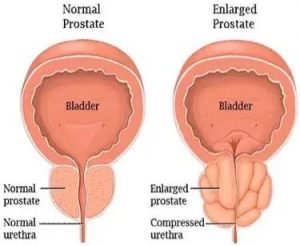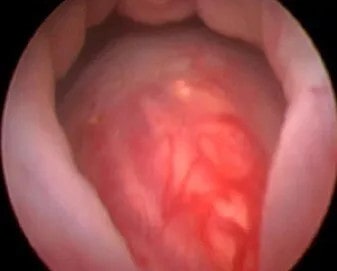Enlarged Prostate
What is Benign Prostatic Hyperplasia (BPH)?
Benign Prostatic Hyperplasia also abbreviated as BPH, is a well-known benign enlargement of the prostate faced by men of advancing age.
BPH causes the prostate gland to become enlarged and causes difficulty during urination. BPH is common and cannot be prevented but is not Prostate Cancer.

Normal Prostate vs BPH
Who Does Benign Prostatic Hyperplasia Affect?
- Around 30% at age 60 experience BPH
- Over 50% of men aged 70 experience BPH with about 30% finding the symptoms bothersome.
- About 90% of men over the age of 85 will have BPH.
- A positive family history,
- obesity,
- cardiovascular conditions and
- pre-existing diabetes
How Does Benign Prostatic Hyperplasia Occur?
BPH occurs as a result of proliferation and increased growth (hyperplasia) of the epithelial and stromal layers of the prostate gland. This is typically in response to hormonal changes which results in enlargement of the gland.
Causes Of Benign Prostatic Hyperplasia?
BPH is a benign enlargement of the prostate gland. The exact causes are not fully understood, however, it may be due to the natural growth process or due to hormonal changes that occur with age, specifically testosterone and dihydrotestosterone (DHT).
Symptoms of Benign Prostatic Hyperplasia
The symptoms caused by BPH are a result of the constriction of the urethra which results in:
- Increased urgency (going to the bathroom frequently)
- Increased need to go to the bathroom at night-time (nocturia)
- Increased frequency of urination
- Dissatisfaction due to incomplete bladder emptying, giving the sensation that you haven’t emptied your bladder fully
- Need to strain during urination
- Weak stream of urine and dribbling after urination
Severity Of Benign Prostatic Hyperplasia
The growth of benign prostatic tissues can be determined by your surgeon and its size can determine the severity of the symptoms. However, prostate size is not always an indicator of symptoms severity.
How is Benign Prostatic Hyperplasia Diagnosed?
The diagnosis of BPH is made by the doctor by performing the following tests:
- History of symptoms, and associated complications
- Digital Rectal Examination
- Blood Tests including PSA (Prostate-Specific Antigen) test
- Urinary Flow Test
- Prostate Biopsy may be done to rule out prostate malignancy
- Cystoscopy
- Ultrasound
- Urodynamics

Cystoscopic Appearance of Enlarged Prostate
How is Benign Prostatic Hyperplasia Treated?
Treatment options for BPH include both medications as well as surgical options, and the best course of therapy is determined by the doctor based on:
- overall health,
- lab results,
- progression of the enlargement, and
- presence of complications due to enlarged prostate
Medications for BPH Treatment
Medicine works best in cases with mild to moderate symptoms and includes
- Alpha blockers – They act by relaxing the neck of the bladder muscles and surrounding tissues, making it easier to urinate.
- 5 Alpha-Reductase Inhibitors – This group of drugs results in size reduction of the prostate gland, again, making urination easier
- Combination – A combination approach can also be given in certain cases. These work by relaxing bladder muscles and shrinking the prostate gland, respectively.
- PDE5 inhibitors – They have been shown to be effective presumably due to the relaxation of the smooth muscle fibers of the bladder and prostate, especially useful in men with erectile dysfunction
- Anticholinergics or beta3 agonist (Mirabegron) – They are not the first line for BPH. However, they relieve overactive bladder symptoms and are useful adjuncts, especially for men suffering severe urge or urge incontinence
Advanced BPH Treatments
- Urolift – tiny implants are placed into the prostate that effectively holds the urethra open. There is no cutting, heating or removal of prostate tissue.
- Trans-urethral Resection Of The Prostate (TURP) – A telescope is inserted via the urethra and the enraged part of the prostate gland is removed
- Trans-urethral Incision Of The Prostate (TUIP) or Bladder Neck Incision (BNI) – for this procedure incisions are only made in the prostate gland to make urination easier
- Rezum – Using water vapour (steam) which is injected into the prostate causing the enlarged parts of the prostate to die and be reabsorbed by the body.
- Laser Therapy – where amplified light energy is used to generate heat to destroy prostatic tissue. There are many different types of laser therapy for BPH.
- Simple Prostatectomy (Open/Robotic) – indicated especially if the above endoscopic option is not most suitable, especially for men with very large or massive prostate gland. Unlike prostatectomy for prostate cancer involving removing the entire prostate (radical prostatectomy), this procedure removes just the part of the prostate that’s blocking the flow of urine (adenomas).
- Embolization– where the blood supply to the prostate is cut, a shrinkage in size is expected to allow easier passing of urine.
In all approaches, a prostate gland MRI or biopsy may also be conducted to rule out prostate cancer, as the symptoms can overlap.
What If Benign Prostatic Hyperplasia Is Untreated
If left untreated, the symptoms caused by BPH may continue to cause the patient mild or severe distress, depending upon the growth of the prostate gland.
Further distress can result from the frequently worrying about having to urinate and constant visits to the bathroom when at work or attending events and at night.
Sometimes, complications such as frequent urine infections, an inability to pass urine at all (retention), bladder stone formation, blood in urine (haematuria), and kidney damage can occur.
